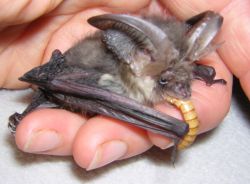A walk on the wild side
13 October was a lucky day for one small bat. When Adam Belsey arrived for work in the Library he found the bat slowly crawling across the carpet, trying to hide under some bookshelves. Adam gently coaxed the bat into a small cardboard box.
 David Streeter
David Streeter
 David Harper
David Harper
 A female juvenile Brown Long-Eared Bat, rescued after being found close to death in the Library
A female juvenile Brown Long-Eared Bat, rescued after being found close to death in the Library
One of the porters contacted Sussex Bat Group, and local expert Kim Dawson arrived in just 30 minutes. Quickly identifying the victim as a female juvenile Brown Long-Eared Bat, Kim rushed her to the Hurstpierpoint Bat Hospital. The Chair of Sussex Bat Group, Amanda Millar, says that the bat had been just "hours from death from starvation and dehydration”. As the photograph shows, a supply of mealworms aided recovery.
The Library building is open 24 hours during the week in term time, and the lights - being on all night - must have been very bright for this strictly nocturnal bat.
Autumn is a punishing time for young bats, freshly independent from their mothers. We reported on 6 October 2006 how an unusual aroma in Professor Nigel Llewellyn’s office in Arts B turned out to be caused by a dead Long-eared Bat! Water loss by evaporation through the bare ears and wing membranes is a particular challenge.
In our last column (Bulletin 7 October) we mentioned the biannual drama of bird migration over campus.
Notable insectivorous species that have arrived to winter in our relatively mild climate include Grey Wagtail, Black Redstart and Firecrest.
As winter approaches it might seem surprising to see insects still visiting flowers, but one familiar plant - Ivy - defers its blooming until September and persists right through to early November.
The flowers are arranged in conspicuous globular umbels, i.e. groups of flower stalks that all arise from the same point (as in Cow Parsley). The individual flowers are small and inconspicuous, with five tiny greenish-yellow petals that are rolled back at the tip.
The Ivy along the playing field edge of the Tenant Lain Belt was covered recently by wasps, attracted by the copious nectar produced by the disc in the middle of the flowers and having a last meal before finally succumbing to their inevitable fate at the close of the year. Only the queens survive the winter in hibernation.
Ivy nectar is one of the most important sources of carbohydrate for insects at this time of year and the crop of black berries that follow the flowers are especially attractive to thrushes and Wood Pigeons.
Ivy is common throughout most of Europe but gets distinctly scarcer the farther east one goes and is more or less absent from Russia. A few years ago we had a visiting student from Poland who suddenly got terribly excited on her first field trip, the cause being her first meeting with Ivy, a rare species in her home country!
